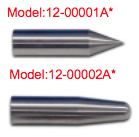ESD simulator
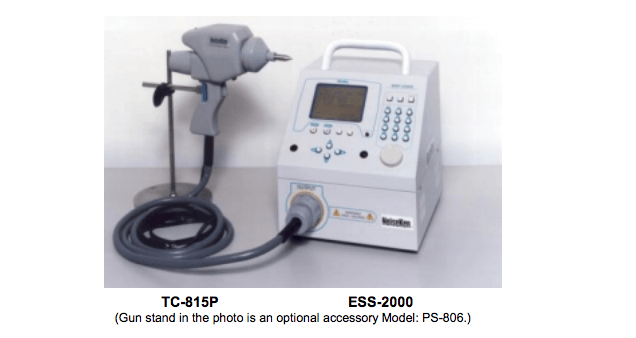
ESS-2000 with Discharge gun TC-815P
Among the causes of equipment malfunction, problems caused by ESD (electrostatic discharge) are the most difficult events against which to incorporate protective measures, since the causal relation generally cannot be found easily. Air discharge testing, which is affected by numerous variable factors, is a widely adopted test method, since the actual ESD events in the field are air discharges.
On the other hand, contact discharges are preferably applied since the following two benefits are obtained: high repeatability and evaluation of ESD susceptibility in terms of discharge voltage. In the contact discharge method, the very fast but stable rise time of discharge current does not vary with charge voltage prior to discharge and the waveforms are proportional to charge voltages, which allows the engineer to define the ESD susceptibility of the equipment under test in terms of charge voltage. This simulator is designed to conduct both contact and air discharge testing.
Features
- This simulator meets and far exceeds the testing requirements in the IEC 61000-4-2, generating discharges up to 30kV. In addition, various waveforms can be generated by changing the energy
- Since the energy storage capacitor, discharge resistor and discharge relay are incorporated in the gun, ESS-2000 is capable of generating current with a stable rise independent of applied voltage, making it possible to conduct a reproducible test.
- This simulator provides four operation modes, allowing the operator to conduct a single step testing for the IEC specified test voltages and for a series of stored test settings.
- . Controllable from an external computer using various communication interfaces.
Specification
| Output voltage | 0.20 a 30.0kV ±5% |
| Polarity | Positive / Negative |
| Charging resistance | 53 M: (for combination with TC-815P discharge gun) |
| Discharge mode | Air discharge and contact discharge |
| Operation mode: IEC severity level | Level setting 1, 2, 3, 4 Discharge interval 0.05 a 600.0s No. of times of discharge 1 a 60000 times |
| Manual | Discharge interval 0.05 a 600.0s No. of times of discharge 1 a 60000 times Setting storage function Up to 10 conditions storable |
| Sweep | Starting voltage ± 0.20 a 30.0kV Step voltage 0.00 a 30.0kV Discharge interval 0.05 a 600.0 S No. of times of discharge 1 a 60000 times Setting storage function Up to 10 conditions storable |
| Program | Voltage setting ± 0.20 a 30.0kV Discharge interval 0.05 a 600.0s No. of times of discharge 1 a 60000 times No. of steps 30 steps maximum No. of programs Up to 50 conditions storable No. of program units Up to 100 conditions can be set. |
| Temp. and humidity measurement | Current values are displayed |
| Display element | LCD with back light |
| Character display | English or Japanese |
| Setting method | Ten-key pad , Rotary control, Function keys |
| Auxiliary function | Upper limit voltage setting function Trigger switch select function Auto stop function Inversion on the screen function |
| Clock function | Year, month, day, hour, minute (Battery backup) |
| Memory function | Clock work, contents of each setting and last operation display are backed up for more than 3 months with battery full charged. |
| External interface functions | GP-IB connecting I/F iWarning light connecting I/F External trigger input I/F iElimination probe connecting I/F |
| Printer I/F | Conforming to simple CENTRONIX I/F |
| Contents of print | Currently applied voltage/ Current date/ Current temp.
and humidity Contents of various settings |
| Power supply | 90 a 120 / 200 a 240V AC 50/60 Hz |
| Operating temperature and humidity | 0 a 40°C 20 a 70% (No dewing shall occur.) |
| Dimensions and weight: ESS-2000 | 250(W) X 324(H) X 320(D) Approx. 8.0 kg |
| TC-815P | 75(W) X 220(H) X 255 (D) Approx. 0.9 kg (Except a cable) |
DISPLAY EXAMPLE

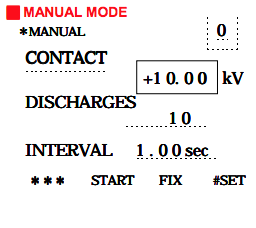
If you desire to operate the unit in the manual mode, press the corresponding ten-key, 2. Items to be set by the operator will appear. Discharge method (contact/air discharge), discharge voltage, number of discharges and interval can be set. The item in the cursor can be varied by using the ten-key or rotary knob.
Contact discharges: For contact discharge testing, after completion of required settings, press the START button and pull the trigger. The simulator will then generate the required number of pulses at the required interval. Pulling the trigger again will pause the unit. Pulling again will restart the unit .
Air discharges: For air discharge testing, after completion of setting, press the START key. To carry out air discharges, keep pulling the trigger and approach the discharge tip to the EUT. Keep pulling the trigger to maintain the HV relay in the on status.
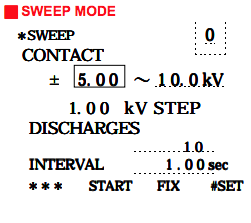
In this mode, the simulator generates discharges in an automatic ramp. Starting, ending and step voltages can be freely set. In this mode, the number of discharges set is that in each step. For example, when the simulator is set to 5kV for start voltage. 10kV for end voltage, 1kV for step voltage, in a way of 10 discharges at an interval of 1 second, it produces 10 pulses at 5kV at an interval of 1 second and proceeds to 6kV pulses, also 10 discharges. These steps continue until the simulator has completed 10 pulses of 10kV.
Two different ways of pulling the trigger: When the trigger is pulled and then released quickly, the simulator operates in a way that it pauses before it proceeds to next step voltage. For continuous operation, pull the trigger for more than 2 seconds. The message of “CONTINUOUS” is indicated on the upper right side of the screen.
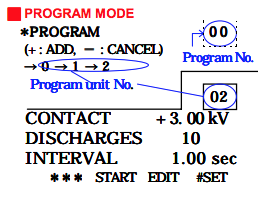
Test settings can be stored for 100 program units. Any combination of units selected from those 100 units can consist of one test sequence, the longest is up to 30 units. Here we call one test sequence a program. 50 programs can be stored.
For program unit setting, press EDIT button. Settings of voltage, etc. can be done in the same way as the other operation modes. The trigger functions in the same ways as in the sweep mode. When pulled once and released instantly, the simulator operation pauses before it goes to the next program unit. If pulled for than 2 seconds, the simulator operates continuously.
STANDARD ACCESSORIES
- Discharge gun Model: TC-815P
- Discharge electrode Model: 12-00001A and 12-00002A
- Capacitor unit Model: 06-00014A (150pF)
- AC cord
- iDischarge resistor (330)
- Instruction manual
- Accessory bag
CONTROLS, INDICATORS AND TERMINALS
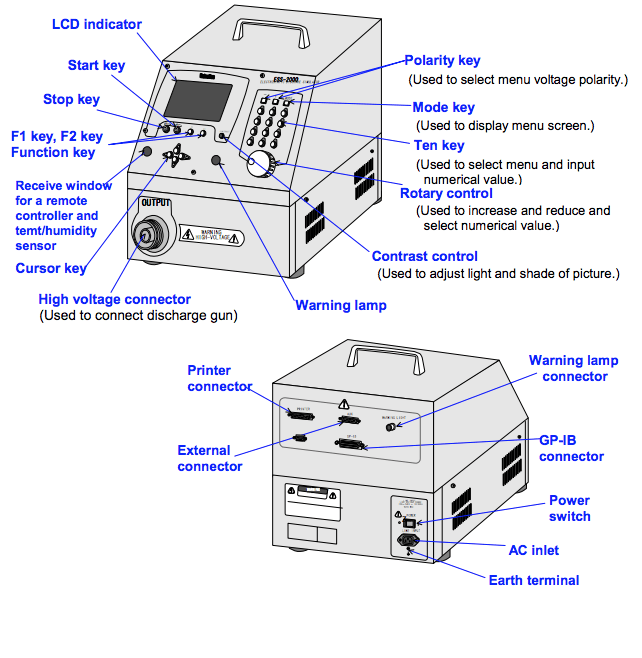
OPTIONS
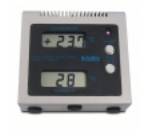
Tem./humidity sensor
Model:07-00016A
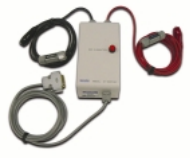
Automatic ESD eliminator
Model: 01-00013A
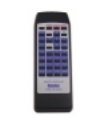
Wireless remote controller
Model: 08-0006B
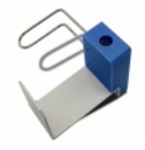
Gun Holder
Model: 03-00040A
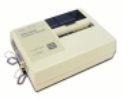
Printer
Model:16-00001A

Printer cable
Model: 05-00005A
Options for TC-815P
Free arm gun stand
Model: 03-00022B
Dimensions: (W)18x(H)76x(D)7cm
Weight: Approx.5kg
Gun stand
Model:PS-806
Dimensions:(H)30cm (Diameter)16cm
Weight: Approx. 1.6kg
Fast rise time adapter
Model:12-00003A

Included accessories for TC-815P
Capacitor unit
100pF: Model 06-00013A
150pF: Model 06-00014A*
200pF: Model 06-00015A
250pF: Model 06-00016A
300pF: Model 06-00017A
330pF: Model 06-00032A
400pF: Model 06-00018A
500pF: Model 06-00019A
Discharge resistor
100,150,200,250,300,330*,
400,500, 1k, 1.5k, 2k, 5k, 10k :
Discharge electrode
